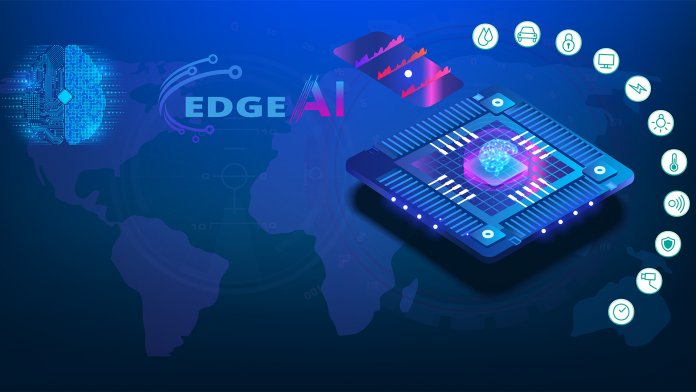In the era of rapid technological advancement, the convergence of artificial intelligence (AI) and edge computing has paved the way for transformative applications and services. Edge AI, the amalgamation of artificial intelligence and edge computing technologies, is revolutionizing the landscape of data processing, analysis, and decision-making. Unlike traditional cloud-based AI systems, Edge AI pushes computational capabilities closer to the data source, unlocking new possibilities and efficiencies. In this blog post, we will explore the concept of Edge AI, its significance, applications, betelgeuse challenges, and the potential it holds for shaping the future of intelligent systems.
Understanding Edge AI:
Edge AI refers to the deployment of artificial intelligence algorithms and models directly on edge devices or local servers, as opposed to relying solely on centralized cloud infrastructure. This decentralized approach minimizes latency, reduces the need for continuous internet connectivity, and enhances privacy and security by keeping sensitive data closer to the source. The edge, in this context, refers to the outer boundaries of the network, encompassing devices like smartphones, IoT devices, drones, cameras, and more.
Key Components of Edge AI:
Edge Devices:
- Edge AI leverages a variety of devices equipped with processing power, such as smartphones, sensors, cameras, and IoT devices.
- These devices act as the frontline data collectors, capturing and processing information at the source.
Local Servers:
- In some cases, edge devices may connect to local servers for additional processing capabilities.
- Local servers act as intermediate processing hubs between edge devices and the centralized cloud, reducing latency and improving response times.
AI Models:
- Edge AI relies on lightweight and efficient machine learning models suitable for deployment on resource-constrained devices.
- These models are optimized for performance while maintaining accuracy, enabling real-time decision-making at the edge.
Applications of Edge AI:
Smart Cities:
- Edge AI enhances the efficiency of urban infrastructure by enabling real-time monitoring and analysis of traffic, waste management, and public safety.
- Traffic signal optimization, waste bin monitoring, and surveillance systems benefit from immediate decision-making at the edge.
Healthcare:
- In healthcare, Edge AI is used for remote patient monitoring, predictive analytics, and real-time diagnostics.
- Wearable devices equipped with AI algorithms can monitor vital signs, detect anomalies, and alert healthcare providers instantly.
Manufacturing:
- Edge AI improves manufacturing processes by enabling predictive maintenance, quality control, and real-time monitoring of production lines.
- Anomaly detection in machinery, automated defect recognition, and optimization of production schedules contribute to increased efficiency.
Retail:
- Retailers leverage Edge AI for personalized customer experiences, inventory management, and security.
- Intelligent cameras and sensors analyze customer behavior, manage inventory levels, and enhance security through real-time threat detection.
Challenges and Considerations:
Resource Constraints:
- Edge devices often have limited processing power, memory, and energy resources, posing challenges for deploying complex AI models.
- Optimizing models for efficiency and designing lightweight algorithms are crucial considerations.
Security and Privacy:
- Decentralized processing raises concerns about data security and privacy, especially when handling sensitive information at the edge.
- Implementing robust encryption, secure communication protocols, and data anonymization are essential for addressing these concerns.
Model Updates and Maintenance:
- Ensuring the seamless update of AI models on edge devices and maintaining consistency across the network can be challenging.
- Edge AI systems must incorporate mechanisms for efficient model deployment, updates, and version control.
Interoperability:
- The diversity of edge devices and platforms calls for standardized protocols to ensure interoperability and seamless integration across different ecosystems.
- Industry-wide collaboration is essential to establish common standards for Edge AI deployment.
The Future of Edge AI:
As technology continues to evolve, the future of Edge AI holds great promise. Here are some trends and developments that are likely to shape the landscape:
5G Integration:
- The rollout of 5G networks will significantly enhance the capabilities of Edge AI by providing faster and more reliable communication between edge devices and local servers.
Federated Learning:
- Federated learning enables edge devices to collaboratively train machine learning models without sharing raw data. This approach enhances privacy and allows for decentralized model training.
Edge-to-Cloud Synergy:
- Edge AI and cloud-based AI will likely coexist in a complementary fashion. Edge devices will handle real-time, local tasks, while the cloud will support more complex and resource-intensive computations.
Autonomous Systems:
- Edge AI will play a crucial role in the development of autonomous systems, such as self-driving cars and drones. Real-time decision-making at the edge is essential for ensuring the safety and efficiency of these systems.
Conclusion:
Edge AI is at the forefront of the technological revolution, ushering in a new era of intelligent systems that operate closer to the source of data. Its applications span various industries, promising increased efficiency, reduced latency, and enhanced privacy. As the technology continues to mature, addressing challenges related to resource constraints, security, and interoperability will be paramount. The future of Edge AI holds the potential to reshape the way we interact with technology, paving the way for a more intelligent and connected world

